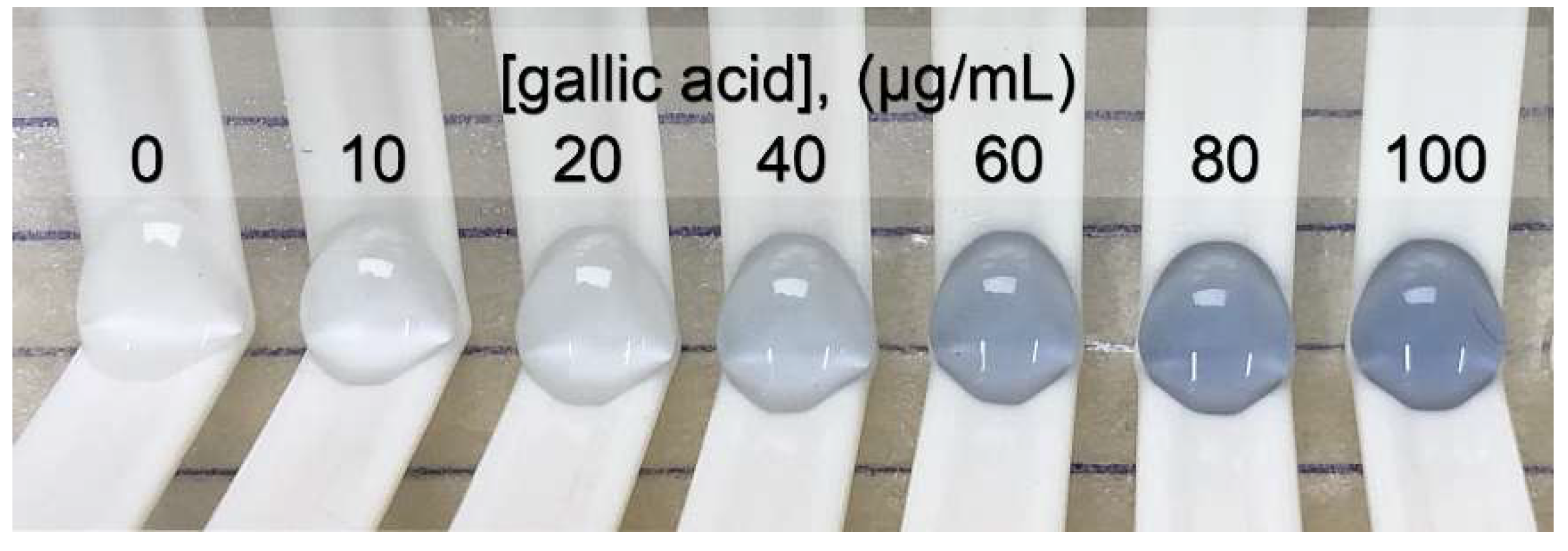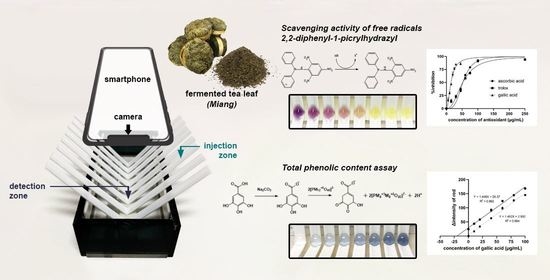A Simple Minimized System Based on Moving Drops for Antioxidant Analysis Using a Smartphone
Abstract
:1. Introduction
2. Results and Discussion
2.1. Scavenging Activity on 2,2-Diphenyl-1-Picrylhydrazyl (DPPH•) Radicals
2.1.1. The Kinetics of the 2,2-Diphenyl-1-Picrylhydrazyl Radical’s Scavenging Activity
2.1.2. Determination of IC50, VCEAC, and TEAC Values
2.2. Total Phenolic Content Assay
2.3. Application and Validation
| Samples | TPC (GAE; mg/g Sample) | |
|---|---|---|
| Proposed Method | Reference Method [31] | |
| Miang No.1 | 24 ± 2 | 25.2 ± 0.5 |
| Miang No.2 | 32 ± 2 | 32 ± 1 |
| Miang No.3 | 14 ± 2 | 12 ± 1 |
3. Materials and Methods
3.1. Reagents and Materials
3.2. Fabrication of the Downscaling Platform Based on a Moving Drop
3.3. Scavenging Activity on 2,2-Diphenyl-1-Picrylhydrazyl (DPPH•) Radicals
3.4. Total Phenolic Content by the Folin–Ciocalteu Reaction
3.5. Application to the Miang (Fermented Tea Leaf) Extract
4. Conclusions
Supplementary Materials
Author Contributions
Funding
Institutional Review Board Statement
Informed Consent Statement
Data Availability Statement
Acknowledgments
Conflicts of Interest
Sample Availability
References
- Silvia, V.; Angela, A.; Stefano, M. The antioxidants and pro-antioxidants network: An overview. Curr. Pharm. Des. 2004, 10, 1677–1694. [Google Scholar]
- López-Alarcón, C.; Denicola, A. Evaluating the antioxidant capacity of natural products: A review on chemical and cellular-based assays. Anal. Chim. Acta 2013, 763, 1–10. [Google Scholar] [CrossRef]
- Saenjum, C.; Pattananandecha, T.; Nakagawa, K. Antioxidative and anti-inflammatory phytochemicals and related stable paramagnetic species in different parts of dragon fruit. Molecules 2021, 26, 3565. [Google Scholar] [CrossRef]
- Pattananandecha, T.; Apichai, S.; Julsrigival, J.; Ungsurungsie, M.; Samuhasaneetoo, S.; Chulasiri, P.; Kwankhao, P.; Pitiporn, S.; Ogata, F.; Kawasaki, N.; et al. Antioxidant activity and anti-photoaging effects on UVA-irradiated human fibroblasts of rosmarinic acid enriched extract prepared from Thunbergia laurifolia leaves. Plants 2021, 10, 1648. [Google Scholar] [CrossRef]
- Pisoschi, A.; Negulescu, G. Methods for total antioxidant activity determination: A review. Anal. Biochem. 2012, 1, 1–10. [Google Scholar] [CrossRef] [Green Version]
- Tobiszewski, M.; Mechlińska, A.; Namieśnik, J. Green analytical chemistry-theory and practice. Chem. Soc. Rev. 2010, 39, 2869–2878. [Google Scholar] [CrossRef] [PubMed]
- Brett, C.M.A. Novel sensor devices and monitoring strategies for green and sustainable chemistry processes. Pure Appl. Chem 2007, 79, 1969–1980. [Google Scholar] [CrossRef]
- Hartwell, S.K.; Grudpan, K. Flow-based systems for rapid and high-precision enzyme kinetics studies. J. Anal. Methods Chem 2012, 2012, 1–10. [Google Scholar] [CrossRef] [Green Version]
- Grudpan, K.; Khonyoung, S.; Hartwell, S.; Lapanantnoppakhun, S.; Jakmunee, J. Down scaling: From operation on lab bench space to manipulation at a valve review. J. Flow Inject. Anal. 2006, 23, 94–101. [Google Scholar]
- Ainla, A.; Jeffries, G.D.M.; Brune, R.; Orwar, O.; Jesorka, A. A multifunctional pipette. Lab. A Chip 2012, 12, 1255–1261. [Google Scholar] [CrossRef] [Green Version]
- Mrazek, N.; Watla-iad, K.; Deachathai, S.; Suteerapataranon, S. Rapid antioxidant capacity screening in herbal extracts using a simple flow injection-spectrophotometric system. Food Chem. 2012, 132, 544–548. [Google Scholar] [CrossRef]
- Polášek, M.; Skála, P.; Opletal, L.; Jahodář, L. Rapid automated assay of anti-oxidation/radical-scavenging activity of natural substances by sequential injection technique (SIA) using spectrophotometric detection. Anal. Biochem. 2004, 379, 754–758. [Google Scholar] [CrossRef] [PubMed]
- Magalhães, L.M.; Segundo, M.A.; Reis, S.; Lima, J.L.F.C. Automatic method for determination of total antioxidant capacity using 2,2-diphenyl-1-picrylhydrazyl assay. Anal. Chim. Acta 2006, 558, 310–318. [Google Scholar] [CrossRef]
- Sirivibulkovit, K.; Nouanthavong, S.; Sameenoi, Y. Paper-based DPPH assay for antioxidant activity analysis. Anal. Sci. 2018, 34, 795–800. [Google Scholar] [CrossRef] [PubMed] [Green Version]
- Nuchtavorn, N.; Macka, M. A novel highly flexible, simple, rapid and low-cost fabrication tool for paper-based microfluidic devices (μPADs) using technical drawing pens and in-house formulated aqueous inks. Anal. Chim. Acta 2016, 919, 70–77. [Google Scholar] [CrossRef] [PubMed]
- Sameenoi, Y.; Nongkai, P.; Nouanthavong, S.; Henry, C.; Nacapricha, D. One-step polymer screen-printing for microfluidic paper-based analytical device (μPAD) fabrication. Analyst 2014, 139, 6580–6588. [Google Scholar] [CrossRef]
- Yang, X.; Sun, M.; Wang, T.; Wah, W.; Huang, D. A smartphone-based portable analytical system for on-site quantification of hypochlorite and its scavenging capacity of antioxidants. Sens. Actuators B 2019, 283, 524–531. [Google Scholar] [CrossRef]
- Vaher, M.; Kaljurand, M. The development of paper microzone-based green analytical chemistry methods for determining the quality of wines. Anal. Biochem. 2012, 404, 627–633. [Google Scholar] [CrossRef] [PubMed]
- Sateanchok, S.; Wangkarn, S.; Saenjum, C.; Grudpan, K. A cost-effective assay for antioxidant using simple cotton thread combining paper based device with mobile phone detection. Talanta 2018, 177, 171–175. [Google Scholar]
- González-Ceballos, L.; Cavia, M.d.M.; Fernández-Muiño, M.A.; Osés, S.M.; Sancho, M.T.; Ibeas, S.; García, F.C.; García, J.M.; Vallejos, S. A simple one-pot determination of both total phenolic content and antioxidant activity of honey by polymer chemosensors. Food Chem. 2021, 342, 1–7. [Google Scholar] [CrossRef] [PubMed]
- Calabria, D.; Mirasoli, M.; Guardigli, M.; Simoni, P.; Zangheri, M.; Severi, P.; Caliceti, C.; Roda, A. Paper-based smartphone chemosensor for reflectometric on-site total polyphenols quantification in olive oil. Sens. Actuator B-Chem 2020, 305, 795–800. [Google Scholar] [CrossRef]
- Apichai, S.; Thajee, K.; Wongwilai, W.; Wangkarn, S.; Paengnakorn, P.; Saenjum, C.; Grudpan, K. A simple platform with moving drops for downscaling chemical analysis incorporating smartphone detection. Talanta 2019, 201, 226–229. [Google Scholar] [CrossRef]
- Gałuszka, A.; Migaszewski, Z.; Namieśnik, J. The 12 principles of green analytical chemistry and the SIGNIFICANCE mnemonic of green analytical practices. Trends Anal. Chem 2013, 50, 78–84. [Google Scholar] [CrossRef]
- Naksuriya, O.; Okonogi, S. Comparison and combination effects on antioxidant power of curcumin with gallic acid, ascorbic acid, and xanthone. Drug Discov. 2015, 9, 136–141. [Google Scholar] [CrossRef] [PubMed] [Green Version]
- Gil, M.I.; Tomás-Barberán, F.A.; Hess-Pierce, B.; Holcroft, D.M.; Kader, A.A. Antioxidant activity of pomegranate Juice and Its relationship with phenolic composition and processing. J. Agric. Food Chem. 2000, 48, 4581–4589. [Google Scholar] [CrossRef] [PubMed]
- Milardović, S.; Iveković, D.; Grabarić, B.S. A novel amperometric method for antioxidant activity determination using DPPH free radical. Bioelectrochemistry 2006, 68, 175–180. [Google Scholar] [CrossRef]
- Leamsomrong, K.; Suttajit, M.; Chantiratikul, P. Flow Injection Analysis System for the determination of total phenolic compounds by using folin-ciocalteu assay. Asian J. Appl. Sci. 2009, 2, 184–190. [Google Scholar] [CrossRef]
- Yoo, K.S.; Lee, E.J.; Leskovar, D.; Patil, B.S. Development of an automated method for folin-ciocalteu total phenolic assay in artichoke extracts. J. Food Sci. 2012, 77, C1279–C1284. [Google Scholar] [CrossRef]
- Kodchasee, P.; Nain, K.; Abdullahi, A.D.; Unban, K.; Saenjum, C.; Shetty, K.; Khanongnuch, C. Microbial dynamics-linked properties and functional metabolites during Miang fermentation using the filamentous fungi growth-based process. Food Biosci. 2021, 41, 100998. [Google Scholar] [CrossRef]
- Lee, C.Y.; Sharma, A.; Semenya, J.; Anamoah, C.; Chapman, K.N.; Barone, V. Computational study of ortho-substituent effects on antioxidant activities of phenolic dendritic antioxidants. Antioxidants 2020, 9, 189. [Google Scholar] [CrossRef] [Green Version]
- Chen, C.; Wang, L.; Wang, R.; Luo, X.; Li, Y.; Li, J.; Li, Y.; Chen, Z.J.F.C. Phenolic contents, cellular antioxidant activity and antiproliferative capacity of different varieties of oats. Food Chem. 2018, 239, 260–267. [Google Scholar] [CrossRef] [PubMed]
- Lai, L.-S.; Chou, S.-T.; Chao, W.-W. Studies on the antioxidative activities of Hsian-tsao (Mesona procumbens Hemsl) leaf gum. J. Agric. Food Chem. 2001, 49, 963–968. [Google Scholar] [CrossRef] [PubMed]
- Singleton, V.L.; Orthofer, R.; Lamuela-Raventós, R.M. Analysis of total phenols and other oxidation substrates and antioxidants by means of folin-ciocalteu reagent. Meth. Enzym. 1999, 299, 152–178. [Google Scholar]





| Antioxidants | IC50 (μg/mL) | VCEAC | TEAC | |||
|---|---|---|---|---|---|---|
| Proposed Method | Reference Method | Proposed Method | Reference Method | Proposed Method | Reference Method | |
| Ascorbic acid | 52 ± 1 | 53.0 ± 0.3 | 1.00 ± 0.03 | 1.00 ± 0.01 | 0.99 ± 0.10 | 0.98 ± 0.02 |
| Trolox | 52 ± 2 | 49.0 ± 0.3 | 1.04 ± 0.07 | 1.04 ± 0.03 | 1.00 ± 0.06 | 1.00 ± 0.03 |
| Gallic acid | 14 ± 1 | 15 ± 1 | 2.63 ± 0.10 | 2.60 ± 0.09 | 2.40 ± 0.1 | 2.50 ± 0.08 |
| Miang No.1 | 618 ± 37 | 638 ± 5 | 0.36 ± 0.03 1 | 0.35 ± 0.01 1 | 0.36 ± 0.03 2 | 0.33 ± 0.01 2 |
| Miang No.2 | 409 ± 18 | 425 ± 8 | 0.40 ± 0.04 1 | 0.38 ± 0.01 1 | 0.39 ± 0.04 2 | 0.37 ± 0.01 2 |
| Miang No.3 | 1119 ± 56 | 1063 ± 44 | 0.18 ± 0.02 1 | 0.18 ± 0.01 1 | 0.18 ± 0.02 2 | 0.17 ± 0.01 2 |
Publisher’s Note: MDPI stays neutral with regard to jurisdictional claims in published maps and institutional affiliations. |
© 2021 by the authors. Licensee MDPI, Basel, Switzerland. This article is an open access article distributed under the terms and conditions of the Creative Commons Attribution (CC BY) license (https://creativecommons.org/licenses/by/4.0/).
Share and Cite
Apichai, S.; Thajee, K.; Pattananandecha, T.; Saenjum, C.; Grudpan, K. A Simple Minimized System Based on Moving Drops for Antioxidant Analysis Using a Smartphone. Molecules 2021, 26, 5744. https://doi.org/10.3390/molecules26195744
Apichai S, Thajee K, Pattananandecha T, Saenjum C, Grudpan K. A Simple Minimized System Based on Moving Drops for Antioxidant Analysis Using a Smartphone. Molecules. 2021; 26(19):5744. https://doi.org/10.3390/molecules26195744
Chicago/Turabian StyleApichai, Sutasinee, Kajorngai Thajee, Thanawat Pattananandecha, Chalermpong Saenjum, and Kate Grudpan. 2021. "A Simple Minimized System Based on Moving Drops for Antioxidant Analysis Using a Smartphone" Molecules 26, no. 19: 5744. https://doi.org/10.3390/molecules26195744
APA StyleApichai, S., Thajee, K., Pattananandecha, T., Saenjum, C., & Grudpan, K. (2021). A Simple Minimized System Based on Moving Drops for Antioxidant Analysis Using a Smartphone. Molecules, 26(19), 5744. https://doi.org/10.3390/molecules26195744







